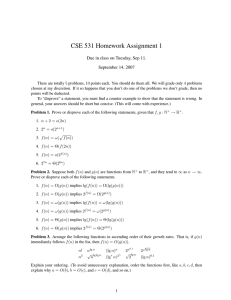1. Implication The statement “p implies q” means that if p is true, then
advertisement
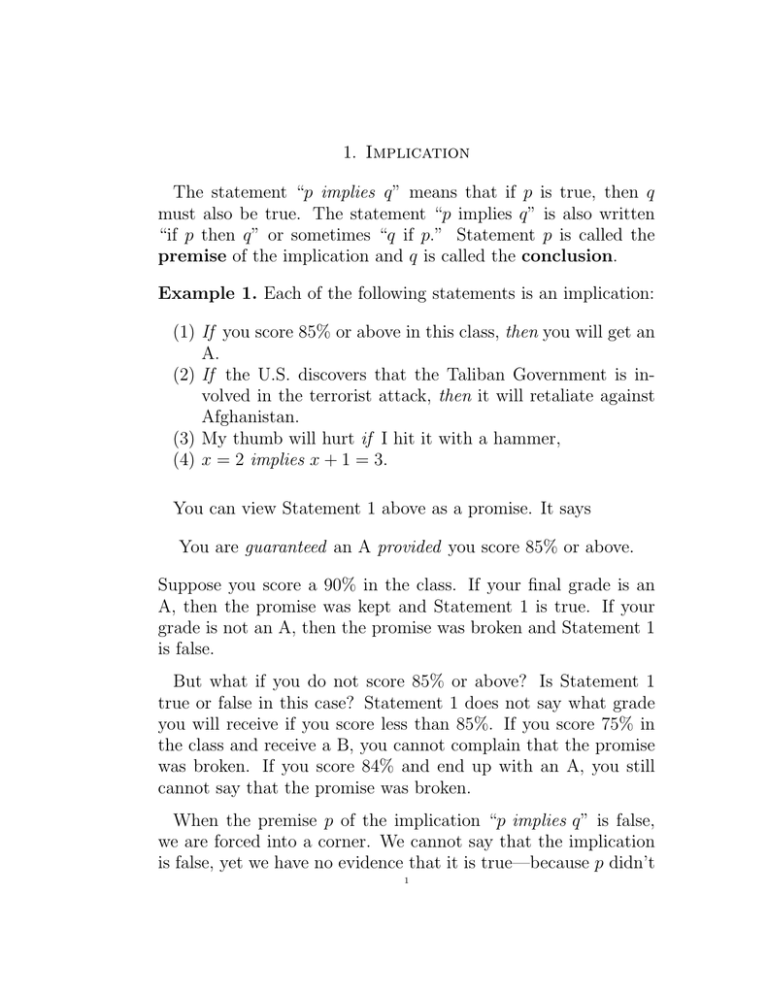
1. Implication The statement “p implies q” means that if p is true, then q must also be true. The statement “p implies q” is also written “if p then q” or sometimes “q if p.” Statement p is called the premise of the implication and q is called the conclusion. Example 1. Each of the following statements is an implication: (1) If you score 85% or above in this class, then you will get an A. (2) If the U.S. discovers that the Taliban Government is involved in the terrorist attack, then it will retaliate against Afghanistan. (3) My thumb will hurt if I hit it with a hammer, (4) x = 2 implies x + 1 = 3. You can view Statement 1 above as a promise. It says You are guaranteed an A provided you score 85% or above. Suppose you score a 90% in the class. If your final grade is an A, then the promise was kept and Statement 1 is true. If your grade is not an A, then the promise was broken and Statement 1 is false. But what if you do not score 85% or above? Is Statement 1 true or false in this case? Statement 1 does not say what grade you will receive if you score less than 85%. If you score 75% in the class and receive a B, you cannot complain that the promise was broken. If you score 84% and end up with an A, you still cannot say that the promise was broken. When the premise p of the implication “p implies q” is false, we are forced into a corner. We cannot say that the implication is false, yet we have no evidence that it is true—because p didn’t 1 2 happen. This situation is reminiscent of the following dialogue from the Three Stooges: Larry: I couldn’t say ‘yes’ and I couldn’t say ‘no’. Curly: Could you say ‘maybe’ ? Larry: I might. Moe: [Hits them both on the head.] Logicians have decided to take an “innocent until proven guilty” stance on this issue. An if—then statement is considered true until proven false. Since we cannot call the statement p implies q false when p is false, our only alternative is to call it true. So the chart for implies is: The if—then Chart: p T T F F q p implies q T T F F T T F T We emphasize again the surprising fact that a false statement implies anything. Example 2. (1) Does 2 = 3 imply 2 + 1 = 3 + 1? Yes, it’s an example of the rule x = y implies x + 1 = y + 1. (2) Does 2 = 3 imply 2 · 0 = 3 · 0? Yes, it’s an example of the rule x = y implies xz = yz. Example 3. Consider the following implications (1) If elephants can fly, then the Cubs will win the World Series this year. 3 (2) If elephants can fly, then the Cubs will lose the World Series this year. Both statements are true—assuming, of course, that elephants can’t fly. Warning to die hard Cubs fans: please do not take Statement 1 too seriously and push elephants out of trees, hoping that one might fly. Example 4. Consider the following implications (1) If hydrochloric acid (HCl) and sodium hydroxide (NaOH) are combined, then table salt (NaCl) will be produced. (2) If March has 31 days, then dogs are mammals. Both statements are true. The first statement is an example of cause and effect and reflects the chemical equation HCl + NaOH = NaCl + H2 O. In the second statement, there is clearly no causal relation between days of the month and dogs being mammals. Both the premise and the conclusion of Statement 2 are true, so according to the chart, the implication is true. The point here is that the use of implies in logic is very different from its use in everday language to reflect causality. From the chart we see that the implication if p then q is false when it happens that p is true, but q is false. This leads us to the surprising conclusion that the negation of an implication is an and statement. The negation of the statement p implies q is the statement p and not q. 4 Example 5. (1) The negation of if I hit my thumb with a hammer, then my thumb will hurt is I hit my thumb with a hammer and my thumb does not hurt. (2) The negation of if Sosa is traded, then Cubs attendance will drop is Sosa is traded and the Cubs attendance does not drop. Example 6. The Four Card Problem You are shown one side of four cards. You are told that each card has a number on one side and a letter on the other side. You are to test the rule: if a card has a vowel on one side, then it has an even number on the other side. You want to find out whether the rule is true or false. What are the only cards you need to turn over to test the rule (and why) if the cards pictured in front of you are: E K 4 7 [The answer is given at the end of this section.] The converse of the statement p implies q is the statement q implies p. Example 7. The converse of if an elephant walks in Mom’s garden, then her tomato plants 5 will be ruined is if Mom’s tomato plants are ruined, then an elephant was walking in her garden. It is clear from this example that a statement is not logically equivalent to its converse. There could be other causes for ruined tomato plants besides promenading pachyderms. The inverse of the statement p implies q is the statement not p implies not q. The contapositive of the statement p implies q is the statement not q implies not p. Example 8. Statement: Converse: Inverse: Contrapositive: If If If If the the the the gloves fit, then the jury will acquit. jury acquits, then the gloves fit. gloves don’t fit, then the jury won’t acquit. jury doesn’t acquit, then the gloves don’t fit. It can be shown by using truth charts that a statement is logically equivalent to its contrapositive and the converse is logically equivalent to the inverse. 6 Example 9. The statement if I hit my thumb with a hammer, then my thumb will hurt is logically equivalent to if my thumb doesn’t hurt, then I didn’t hit is with a hammer. Example 10. Stated as an if–then sentence, the Golden Rule becomes if you want other people to act in a certain way to you, then you should act that way towards them. The inverse of the Golden Rule is if you don’t want other people to act in a certain way to you, then you should not act that way towards them. Many people consider the inverse (or equivalently, the converse) of the Golden Rule to be a more reasonable moral law. The biconditional statement p if and only if q means that both p and q are true or else they are both false. The if and only if Chart: p T T F F q p if and only if q T T F F T F F T The biconditional p if and only if q is logically equivalent to saying p implies q and q implies p. Example 11. You are eligible to vote in a United States election if and only if you are a United States citizen, 18 years or older, and not a convicted felon. 7 The answer to the four-card problem is: you only need to turn over cards ‘E’ and ‘7’.

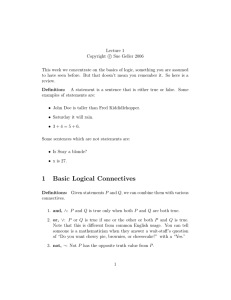
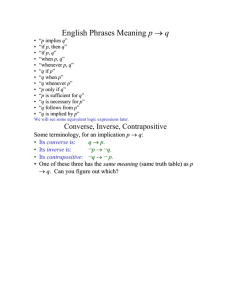
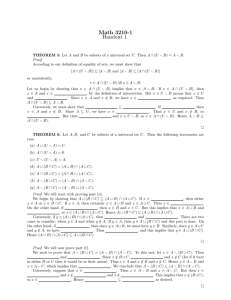
![SOLUTION OF HW3 September 24, 2012 1. [10 Points] Let {x](http://s2.studylib.net/store/data/011168953_1-36e45820ffc71e8ec27ae652a93485b4-300x300.png)
